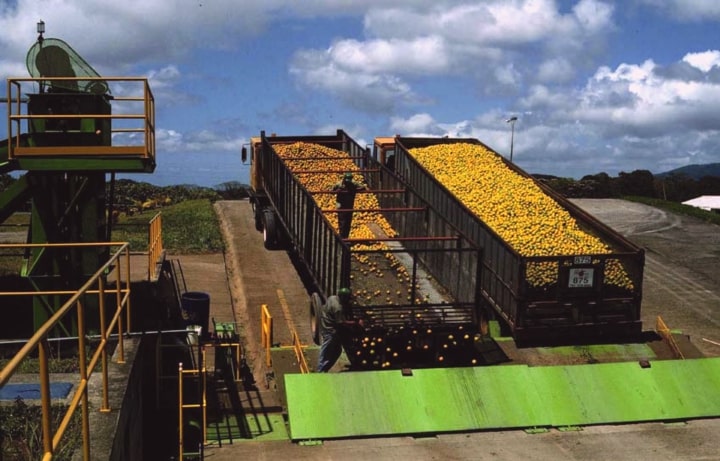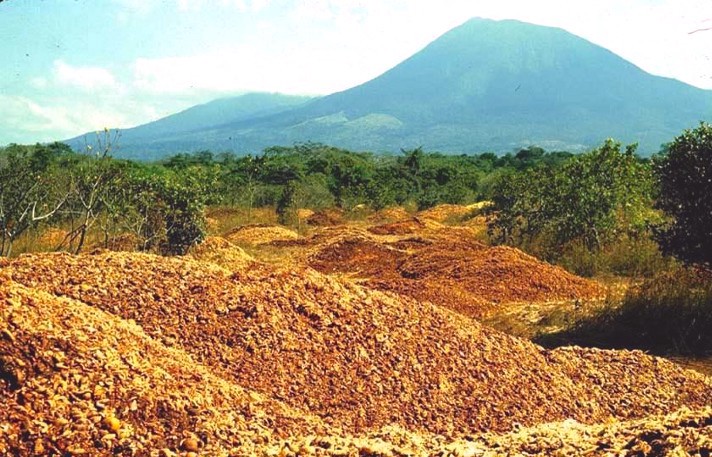Orange isn’t just the new black. It’s also the new green. Twenty years ago, an orange juice producer dumped thousands of tons of orange peels and pulp onto a barren section of a Costa Rican national park, which has since transformed into a lush, vine-laden woodland. The shift is a dramatic illustration of how agricultural waste can regenerate a forest and sequester vast sums of carbon — for free.
Even more remarkable, it was an accident.
“I was totally floored,” said Timothy Treuer, a Princeton University researcher and lead author of a new study published in the journal Restoration Ecology about the rejuvenated forest. “The area that received the orange peels was divided from the [area that did not receive the peels] by a single track dirt road, but the two areas looked like completely different ecosystems.”
On one side was a pasture “with a few scattered scraggly trees,” he said. On the other, “was an overgrown jungle, so lush it required a machete to move through. Once I was done picking my jaw up off the ground, I realized that I was looking at something truly special. It blew my mind.”
Scientists have long worried about the impact of food production on climate change. So they are devising new ways to use food waste that might otherwise end up in a landfill, where it would decompose into methane, a powerful greenhouse gas. The goal is to create new products from the waste, whether they be foods, clothes, farms or — in this case — forest.
“Tropical forests are a part of our species’ collective cultural and natural heritage,” said Jonathan Choi, a co-author who studied the region while a senior at Princeton University majoring in ecology and evolutionary biology. “While we obviously want to protect every forest that remains on this planet, the idea that we might be able to help regrow the forest that we’ve lost in a way that saves everyone money is exciting.”
Here’s what happened.
During the 1990s, 1,000 truckloads of peels and pulp amounting to 12,000 metric tons were deposited as part of a deal struck with Del Oro, an orange juice manufacturer that had just begun production along a northern border of Costa Rica’s Área de Conservación Guanacaste, a national park.

A husband and wife team, Daniel Janzen and Winnie Hallwachs, both ecologists at the University of Pennsylvania — who also worked in the park as researchers and technical advisers — offered the company the opportunity to dump their orange waste on degraded land if Del Oro would donate part of their own forested land to the national park. The company, which had considered building an expensive facility to safely deal with the waste, readily agreed. After first extracting the oils and acids — which are commercially valuable in household cleaning products — the process began.
But, a year after the contract was signed — and the peels and pulp were left on the land — a rival fruit company, TicoFruit, sued to stop the process, arguing that Del Oro had “defiled a national park.” The Costa Rican Supreme Court agreed, halting the dumping. The land was pretty much forgotten over the ensuing years.
In 2013, while Treuer was discussing possible research projects with Janzen, they talked about the site in Costa Rica, wondering whether it was time to take look. On a subsequent research trip to Costa Rica, Treuer decided to stop by.
“It took me two trips to the site to actually figure out where it was,” he recalled. “It didn’t help that the six foot long sign with bright yellow lettering marking the site was so overgrown with vines that we literally didn’t find it until years later after dozens and dozens of site visits.”
The research team evaluated two sets of soil samples to determine whether the orange peels were responsible for enriching the soil’s nutrients. “Essentially we took a measuring tape, stretched it out 100 meters, and measured and identified every tree with three meters of the tape,” Treuer explained. “We did this three times in the fertilized area, laying the tape out in parallel lines 25 meters apart, and three times in the unfertilized area on the other side of the dirt road.”
They looked at changes in tree growth and soil nutrients between the orange peel site and an abandoned pasture that was 100 yards away. They found dramatic differences between the two studied areas; the land fertilized by the orange peels had richer soil, more tree biomass, a greater variety of tree species, and a larger forest canopy closure.

“One of the most surprising results of our tree survey was the number, size and diversity of trees in the area treated with orange peels,” Treuer said. “I was expecting a field of Cecropia — a fast-growing ‘pioneer’ species that often pops up along roadsides and heavily disturbed areas — but two of the most common species were [those] associated with old-growth forests. One of the fig trees we measured was already so large it would have taken three people to wrap their arms all the way around it.
“The diversity was even more striking when compared to the control area that hadn’t been treated with orange peels, where just two pasture-associated species made up the vast majority of trees,” he added.
How did the orange peels work their magic?
“That’s the million dollar question that we don’t yet have the answer to,” Treuer said. “I strongly suspect that it was some synergy between suppression of the invasive grass and rejuvenation of heavily degraded soils. There’s plenty of evidence of both of those factors limiting forest recovery in other parts of the tropics.”
Choi agreed. “We’ll unfortunately never know what the exact mechanisms for regrowth were in this system, given that we don’t have data from before the oranges,” he said. “But we imagine that putting this amount of orange peel on the system both infused a ton of nutrients into the soil, and suppressed an invasive grass that was preventing the growth of additional trees.”
The researchers hope that the insights gained from this unintentional experiment will inspire more collaboration in the future between the private sector and the environmental community.
“We live in a paradoxical world where nutrient starved degraded lands and nutrient-rich waste streams occur simultaneously,” Treuer said. “Resolving that paradox means profits for private industry, more resources for conservation areas, and potentially gigatonnes of climate change-causing gases getting sucked out of the atmosphere.
“This wasn’t just a win-win partnership between a business and a park,” he added. “It turned out to be a win-win-win blueprint, where the biggest winners are everyone who cares about handing off as healthy and robust an environment to their kids as they inherited from their parents.”
Marlene Cimons writes for Nexus Media, a syndicated newswire covering climate, energy, policy, art and culture.

